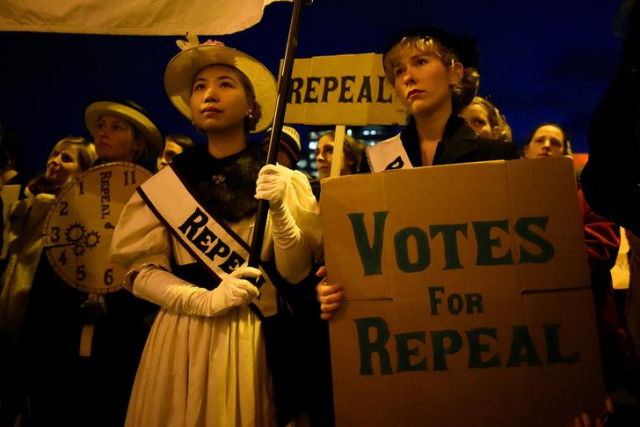Women and men are different in what they need from city living, say experts
Decisions on how money is spent and cities are planned are largely made by men, stifling women's rights

Demonstrators hold posters as they march for more liberal Irish abortion laws, in Dublin, Ireland. PHOTO: REUTERS
Decisions on how money is spent and cities are planned are largely made by men, stifling women's rights in the world's most urbanised region, according to urban experts and women's rights leaders at a conference on cities this week in Bogota.
Across the region, women account for just one in seven elected mayors, according to the United Nations.
American woman describes brutal treatment by Taliban captors
Women live in cities differently from men mainly due to their traditional roles caring for children, elderly relatives and the sick, experts said. Those roles mean women use child care, health clinics and schools more than men do, and they spend more time on public
transport to reach them, they said.
"Most important is the proximity of services. We've learned it's about location, location, location," said Ana Falu, chair of an advisory group on gender issues for UN-Habitat, an urban development agency.
Women also face the threat of sexual assaults on public transport and streets far more than men do, especially those who live in fringe slums and may face long commutes.
60% of US women 'sexually harassed': poll
A 2014 Thomson Reuters Foundation poll found Bogota, Mexico City and Lima had the most dangerous public transport for women out of 16 of the world's largest capitals.
To address the dangers, women's rights groups in Latin America have campaigned for hiring more women drivers, improving lighting and using more security cameras and female police.
In Bogota, women security committees monitor neighbourhoods to identify and map hot spots of crimes, especially those affecting women, including sexual violence.
"We thought it was important that we didn't just speak about murders and robberies but violence women experience too," said Luz Eugenia Dreszer, head of a security committee in Bogota's Usaquen neighborhood.
This month, two municipalities in Chile's capital Santiago announced they would issue on-the-spot fines for sexual harassment on the street, including catcalls.
Sindh police ensure safe space for women, children
"I don't know how successful this will be, but at least it's a gesture," said Soledad Larrain, who heads the Sustainable Mobility Collective in Santiago.
In Latin America, some 80 percent of its 600 million people live in cities, more than anywhere else. A key challenge is helping women in slums who need decent housing, especially in hilltop areas prone to flooding and mudslides during rainy seasons, said Roberto Lippi, UN-Habitat head for the Andean region.
"We aren't taking this seriously, and this causes a huge amount of victims," he said.



















COMMENTS
Comments are moderated and generally will be posted if they are on-topic and not abusive.
For more information, please see our Comments FAQ